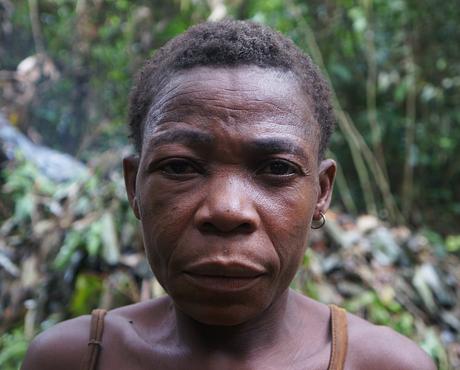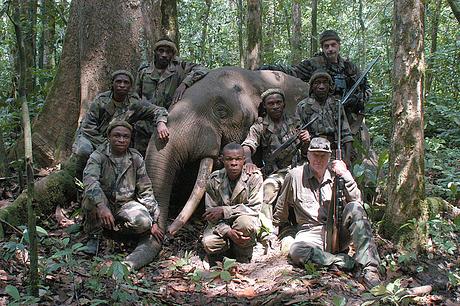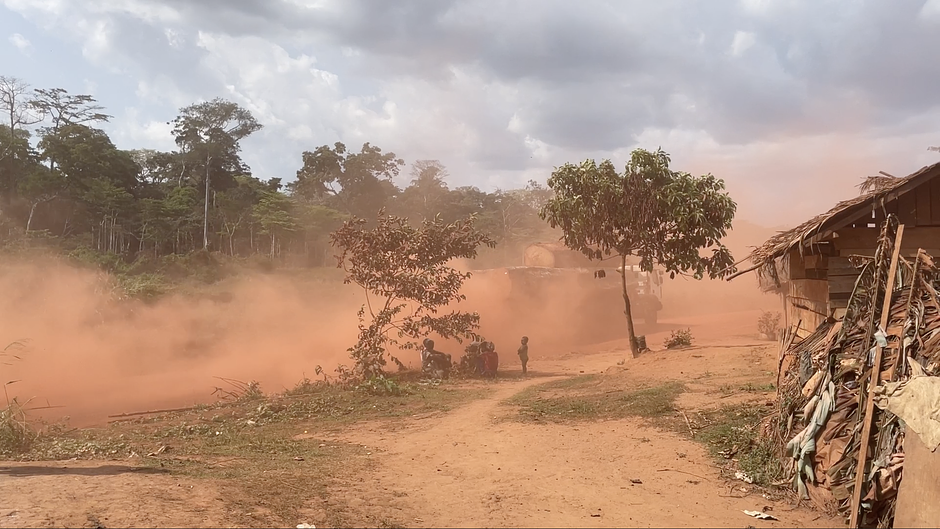The two faces of conservation

By Stephen Corry, former Director
A version of this article appeared as When Conservationists Militarize, Who’s the Real Poacher? in Truthout on August 9, 2015.
This is the third article in former Director Stephen Corry’s series on conservation. For a full list of all articles, please click here.
Kinessa Johnson says, “We’re going to do some anti-poaching, kill some bad guys, and do some good.” Great – who’s to argue! She’s one of the former soldiers in VETPAW. Started by an ex-marine to give employment to post-9/11 veterans and paid for with public donations, they go to Africa to “de-fund” terrorism. It’s a win-win: veterans get work; terrorists don’t get money; animals are saved; and the bad guys are destroyed. If, that is, poaching does fund terrorism. Is Kinessa the face of modern conservation?
The renaissance in “green militarism” goes beyond one American not-for-profit. It’s a “renaissance” because armed environmentalism isn’t new. When national parks were created in 19th century United States, the cavalry first got rid of the Native Americans who lived and hunted there and then kept other “poachers” out. The environmental movement was largely the creation of wealthy big-game hunters who wanted to stop “their” herds being killed by hungry locals. The curious idea that big-game hunters are the best conservationists remains common, and the term “poachers” has always meant only those other hunters that conservationists want to get rid of.
The conservation industry depicts its work as a war that needs fighting with determination. That’s understandable: The environment is losing. Poachers are now portrayed as organized and sophisticated, and fueling depravities such as drugs and terrorism. That’s understandable too: Organizations like WWF – which raises $2 million daily – need to give their donors simple narratives. But the hero versus comic book villain sketch is not the whole story.
Poaching gangs certainly exist, and organizations like VETPAW may be effective in countering them, but is this martial analogy helpful, particularly when conservationists are using more and more real soldiers?
Local people, including local tribespeople, have long been thought “in the way” of the environment. They’re termed “poachers” and abused accordingly. Baka “Pygmies” in Cameroon, Bushmen in Botswana, and Adivasi tribes in India are beaten up or worse by those claiming to protect nature. It’s not getting better.
The United Nations and BirdLife are bankrolling a massive $26 million project in Botswana which includes targeting “subsistence poaching” – in other words, people like the Bushmen who hunt for their food. Such self-righteously preening projects create hostility in their many victims, and this foments a growing problem for conservationists. Keeping local people on your side should surely be a top priority, especially those who’ve lived there for generations and know the environment incalculably better than any environmentalist. Exactly the reverse is happening.
Innocent people are persistently criminalized, including with barefaced fabrication. For example, when Botswana’s president evicted the Bushmen from their ancestral lands in 2002, the government and its cronies – including some in the British Parliament – repeated ad nauseam that the tribe hunted “from trucks” with “high-velocity” weapons. It was an invention, as officials eventually admitted in court: The Bushmen hunt with spear or bow and arrow to feed their families and don’t threaten wildlife survival. Nevertheless, Botswana’s president, General Khama (a board member of Conservation International), is lauded by conservationists for his recent countrywide hunting ban in spite of the fact that it’s unconstitutional. It’s a renewed effort to get rid of the Bushmen, though his ban applies to everyone – apart from safari hunters of course. Rich whites – they are almost invariably white – pay to shoot pretty much anything; black African hunters on the other hand, face arrest, beatings and death.

Botswana is one of many destinations reliant on tourist dollars which have shoot on sight policies. It’s impossible to get the facts when park guards kill “poachers”: Rangers always claim they were fired on first, and no one alive can say differently. However, sometimes the guards’ own reports can paint a picture at odds to the heavily armed gangs we’re told about.
For example, a few months ago the Zimbabwe Parks Authority reported that a band of three had shot at guards in Matusadona National Park using a “heavy caliber gun.” Guards promptly killed two, the other fled. The officials described what they found: one .303 rifle; seven rounds of ammunition; a cooking pot and some buffalo meat – as is served in restaurants all over Africa.
The .303 is not a “heavy caliber gun”; it’s an ancient British infantry rifle, first issued no less than 120 years ago and used by the police and armies in former British colonies until recent decades. If poaching is as profitable as is claimed, this “gang” would have surely stretched to something more up to date and packed more bullets. It’s far from being an isolated incident: Last year two men were killed in the Zambezi National Park. On this occasion, no weapon or ammunition were found: Relatives say the victims were unarmed and collecting wood. In a separate incident, Botswana soldiers were recently accused of faking a crime by planting tusks near the bodies of three men they shot dead. Similar accounts are growing.
It’s not confined to Africa: Locals near Kaziranga National Park in India are reportedly paid to inform on poachers. If someone is subsequently killed, the informant is given up to $1,000, a small fortune locally and a big incentive to point a finger. According to local wildlife expert Firoz Ahmed, “Sometimes we… know what (the poachers) are planning before they act… and they get killed.” In other words, people are extrajudicially executed after a third party, with a vested financial interest, claims they’re planning a crime against animals; the guards on the other hand have immunity from prosecution.
Many Western conservationists welcome extreme measures. As far as they’re concerned, if there’s reason to think that people are hunting elephant for example – that social, intelligent and much loved animal – they deserve nothing other than to be perfunctorily gunned down.
Yet there’s more than one contradiction in this: Trophy hunters also routinely kill elephants, legally. When Baka land in Cameroon was stolen from the “Pygmies” for “protected zones,” WWF played an important role in carving up the territory which included safari hunting concessions, and logging areas, as well as national parks. The industrial-strength NGO steadfastly ignores requests to release the records which would show what it agreed to and claims, entirely falsely, that the Baka consented to their land being taken.
Conservationists actually profit from trophy hunting, as infamously illustrated by the 2014 auction in which a member of the Dallas Safari Club paid $350,000 to kill an endangered black rhino in Namibia. His club is now a fully-fledged component of WWF’s partner, the International Union for the Conservation of Nature.
Conservationists themselves hunt elephants. This can make sense in some places. Botswana’s Chobe Park is thought to have seven times the number of elephants it can support, resulting in a catastrophic loss of plant and animal diversity. Now that traditional tribal hunters have been largely wiped out by environmental regulations, letting Earth’s largest land creature multiply without control is a terrible idea for the environment.
The two-facedness of “hunting” and “poaching” is exemplified by Geoffroy de Gentile Duquesne, employed by a Spanish company, Mayo Oldiri, to run a sport hunting concession in a “protected area” in Cameroon. Amongst his clients was South African, Peter Flack, hunting for endangered forest elephants. Flack writes about his expensive adventure in 2012: He wanted to bag “a full skin” “for mounting purposes.” Confusingly, he writes elsewhere, “Only a short sighted, stupid criminal would hunt endangered game.” Given a “hunter of the year” award six years earlier, the former mining magnate is a WWF trustee.

It gets worse. Flack’s guide didn’t just help rich hunters kill big game in his “protected” area, he also shot dead a supposed poacher (in “self-defense,” needless to say). In other words, some conservationists kill elephants as well as elephant poachers.
This brings conservation back to its historical roots: The attempt to stop poor people hunting for food, so leaving the game exclusively for the rich. The term “poacher” is expanding: It spans organized and highly profitable outlaws to tribal people trying to feed their families. It also encompasses some officials who are paid to stop poaching. But does it also include those who fund terrorists, a claim often repeated by supporters of shoot to kill policies?
Rosaleen Duffy of London’s School of Oriental and African Studies has looked at this in depth. She’s discovered that the claim originates with a single article which refers to one terrorist group, al Shabab in Somalia. It was written by Nir Kalron and Andrea Crosta, director of Elephant Action League, and was originally published in that organization’s website in 2012.
The writers say their “first encounter” with poachers was in a Nairobi hotel. They write, “Following the Shabaab ivory trail into Somalia required assistance from courageous local Somalis,” which implies that they went to Somalia, though they don’t actually say so. Their informants are anonymous, which is to be expected, and there’s no way of checking whether their story is accurate.
The article is loaded with qualifiers, “could be,” “might be,” “may,” and so on, but one concrete detail appears: The poachers told them $200,000-600,000 of ivory supports al Shabab monthly. It’s the higher figure which has become a conservationist mantra, but a fairer response would average the numbers: That would total nearly $5 million a year going to al Shabab from poaching. The Kalron-Crosta article further claims that this “could be supplying up to 40% of the funds needed to keep them in business.” But are their figures right?
It’s thought that the group receives hundreds of millions of dollars from several sources: “taxes” and ransoms they levy from seaports; sympathetic governments; Somali-owned businesses internationally; and even, reputedly, aid organizations and the U.N. which pay protection money (their cash originating of course with Western taxpayers). Five million dollars is certainly a lot (WWF raises the same every 2-3 days) but interestingly it’s still only 12% of the income the U.N. reckons the terrorists amass annually from “taxes,” and this is just one of their many income streams.
Even if the article were correct and poaching funds al Shabab a little, “we” fund it too, through protection money and ransoms paid by the U.N., aid agencies and governments.
Whatever the truth, it’s worth highlighting that this is the sole source which Duffy could find for the poaching-terrorism link, and it was written by someone with a stake in conservationists hiring paramilitaries.
Nir Kalron, the lead writer, is a former “élite commando” who runs Maisha Consulting based in Israel. It provides paramilitaries and weapons training, and together with the Israeli Ministry of Foreign Affairs, partners with WWF and Wildlife Conservation Society (formerly New York Zoological Society). Serious money is available to fight terrorism of course, and Kalron’s certainly a tough operator. As he points out, “It is clear to everyone that we are not do-gooders from some not-for-profit association who will ask people politely to take care of the environment.”
If we take Kalron’s figures at face value, then stopping al Shabab’s ivory trade would still only slightly dent the terrorists’ budget. But are the numbers real? Neither the U.N. nor INTERPOL, for example, believe al Shabab receives significant money from poaching.
Before it frets about terrorists, who are outside its control, the conservation industry might first halt the criminal activity – such as abusing tribal hunters – which we know it does fund. After all, stealing tribespeople’s lands and arresting, beating and torturing them – or worse – is pretty much guaranteed eventually to damage the environment.
It’s time for conservation to stop mouthing platitudes about human rights and start applying them for real. It’s time for it to come clean about its past. It’s also time for it to stop seeing criticism like this as something to be repulsed by public relations lackeys. Until then, it’s difficult to see it doing much lasting good, and there’s no doubt at all it’s hurting innocent people.
Stephen Corry is the former director of Survival International, the global movement for tribal peoples’ rights. The organization has a 47-year track record in stopping the theft of tribal lands. It is working to change conservation, is calling for an end to forced evictions from tiger reserves in India – including the forest where Rudyard Kipling set “The Jungle Book” – and is pressing WWF to stop its funds supporting the abuse of Baka “Pygmies” in Cameroon. Survival’s work on conservation has wide endorsement from environmentalists.





